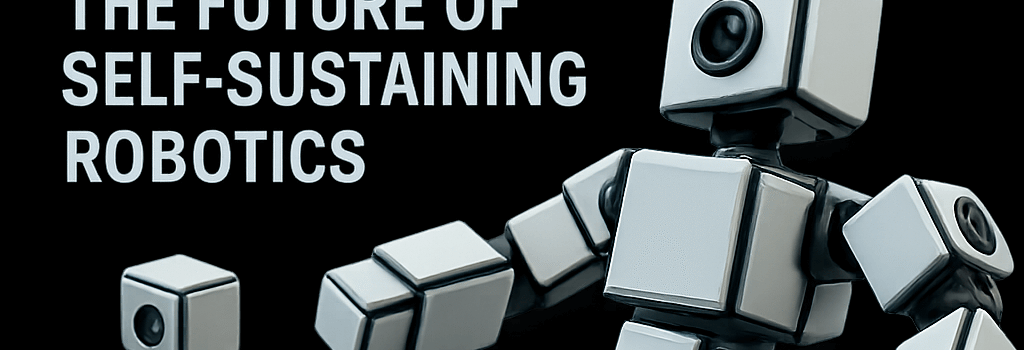Modular Robots: The Future of Self-Sustaining Robotics

Introduction
The notion of robotic metabolism—machines that can consume, reconfigure, repair, and even grow by assimilating other robotic parts—represents a paradigm shift in AI & Machine Learning and Gadgets & Hardware. A team at Columbia University, led by developmental robotics expert Philippe Wyder, recently demonstrated a proof-of-concept platform in Science Advances (2025, DOI: 10.1126/sciadv.adu6897). Their work lays the foundation for self-sustained robotic ecologies that could one day build lunar habitats, ocean observatories, or disaster-response swarms without human intervention.
Nature’s Methods Revisited
“If we want robots to be truly adaptive, we must replicate evolution’s processes, not just its outcomes.” – Philippe Wyder
Biology uses 20 amino acids to assemble trillions of proteins, enabling life’s diversity. Inspired by this, Wyder’s team created a Truss Link module—analogous to a single amino acid. Each link measures 16 cm in length, weighs 120 grams, and integrates:
- a 3.7 V, 1,000 mAh LiPo cell (energy density ~200 Wh/kg)
- an 8-bit microcontroller (8 MHz, 2 kB SRAM)
- two micro-servomotors (stall torque 0.5 N·m, speed 60 rpm)
- permanent neodymium magnets (pull force 5 N)
- an infrared proximity sensor for docking
By tossing dozens of Truss Links into a confined arena with varied terrain, the researchers observed spontaneous self-assembly akin to prebiotic molecular formation on early Earth.
Robotic Growth and Locomotion
Under remote supervision, links formed simple to complex structures:
- Three-pointed star: basic turn capability
- Triangle: bidirectional steering
- Diamond with tail: obstacle negotiation
- Tetrahedron: wall-climbing over 5 cm barriers
- Tetrahedron plus ratchet link: collaborative assembly tool
In simulation (2,000 runs, 20 min each), six randomly moving links achieved self-assembly with these probabilities:
- 64% for dual three-pointed stars
- 8.4% for dual triangles
- 45% for diamond-plus-tail intermediates
They also demonstrated automatic repair: detached links realigned and reconnected within 5 seconds, and malfunctioning modules were replaced from a reservoir pool with a success rate of 72%.
Energy Harvesting and Power Management
Current prototypes rely on precharged LiPo cells, but next-gen modules could integrate:
- thin-film solar cells (efficiency 22%) for ambient light harvesting
- piezoelectric strips to convert vibration into 50 mW pulses
- wireless resonant chargers (Qi-like) embedded in base stations
Recent research at MIT (March 2026) introduced an adaptive power scheduler that extends operational uptime by 40% by dynamically reallocating energy budget based on task complexity. This could enable months-long autonomous deployments in remote locations.
Material Recycling and Sustainability
True metabolism implies chemical transformation. Though Truss Links currently consume only compatible modules, teams at EPFL and Harvard are exploring in-field recycling:
- plastic pyrolysis units to recover feedstock for 3D printing
- lithium-ion remanufacturing lines yielding 80% cell capacity
- magnet recovery systems achieving 90% neodymium reuse
Combining these with local 3D printing could allow robots to fabricate new links from environmental waste, a critical step toward off-Earth exploration missions.
AI-Driven Self-Assembly Optimization
Advances in reinforcement learning now enable modules to learn optimal docking strategies. A March 2026 study from Stanford reports a graph-neural-network controller that reduces self-assembly time by 30% and error rates by 25% across randomized trials. By embedding lightweight ML models on the microcontroller (TensorFlow Lite, 50 kB footprint), each link can:
- predict collision outcomes
- choose assembly partners based on local geometry
- coordinate swarm behavior via infrared communication (bitrate 1 Mbps)
Future Applications and Challenges
Philippe Wyder envisages lunar construction swarms that:
- explore terrain in minimalist scout configurations
- assemble into cranes or connectors on demand
- recycle redundant units for structural reinforcement
“A purpose-driven metabolism is key—survivability is the first objective,” Wyder emphasizes. “Without resilience, a lunar colony builder is just an expensive paperweight.”
However, challenges remain:
- Module diversity: integrating sensors, actuators, and computation at scale
- Robust autonomy: balancing centralized planning with decentralized emergent behavior
- Ethical frameworks: preventing uncontrolled replication or resource monopolization
Deeper Analysis: Toward a Self-Sustained Robot Ecology
Building on Magnus Egerstedt’s Robot Ecology concept, we need to define survivability constraints for robotic swarms. These include:
- energy homeostasis: maintaining battery levels above critical thresholds
- structural integrity: real-time health monitoring of lattice connections
- resource locality: prioritizing nearby modules for efficient growth
By simulating predator-prey scenarios in virtual labs, developers can train swarms to react to hazards (e.g., falling debris, radiation spikes) and optimize their metabolic strategies accordingly.
Regulatory and Ethical Perspectives
As machine metabolism advances, regulatory bodies must address:
- Safety standards for self-replicating systems
- Liability models for autonomous growth in public spaces
- Environmental impact of in-field material recycling
Experts from IEEE and ISO are already drafting guidelines on adaptive modular robotics, with stakeholder workshops scheduled for late 2026.
Conclusion
Robotic metabolism, once a science-fiction trope, is becoming a research reality. By combining modular hardware, AI-driven self-assembly, autonomous energy management, and sustainable recycling, we edge closer to robots that can truly sustain, repair, and evolve themselves. While significant technical and ethical hurdles remain, the progress to date—bolstered by recent breakthroughs at MIT, Stanford, and EPFL—signals a transformative future for robotics in exploration, industry, and beyond.